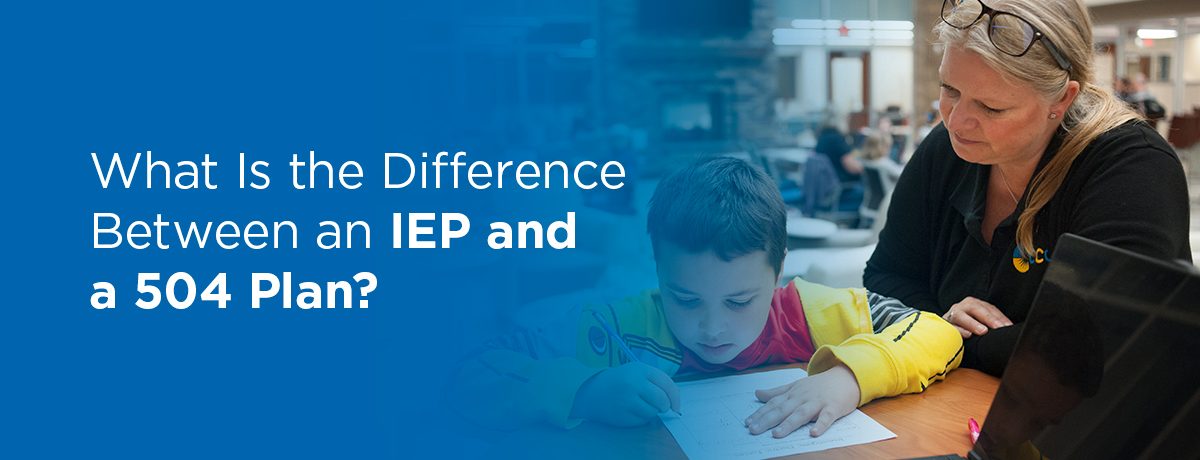2025-2026 School Year Enrollment Now Open. Click Here
2025-2026 School Year Enrollment Now Open. Click Here

IEP and 504 plans are both designed to meet the needs of learners with physical or mental disorders and disabilities. They outline how the student’s educational team accommodates their needs and provides optimal learning environments. An IEP falls under special education laws, and 504 compliance is required under civil rights law.
While there are similarities between these plans, essential differences may make students eligible for one and not the other. Below, we discuss both plans in-depth so you can understand what makes them different and how they are used in the K-12 school system.
An Individualized Education Program (IEP) comes out of the Individuals with Disabilities Education Act (IDEA), an educational law governing the eligibility of children with disabilities for free education and special support. The document helps students with learning disabilities who need accommodations or modifications in the classroom. An IEP includes the following steps:
A 504 service agreement is available to students who do not need or are not eligible for a special education plan or IEP. More specifically, a 504 is under Section 504 of civil rights law. It states that individuals cannot be discriminated against on the basis of disability. Subpart D of section 504 relates specifically to K-12 schools and makes provisions for students who need specific accommodations within the learning environment. It can be granted on an as-needed basis.
Physical or mental disabilities involved with a 504 are often those that hinder major life activities such as:
A student could qualify for a 504 plan temporarily, such as while recovering from surgery. However, there can be cases where a student is receiving care from a doctor for conditions such as ADHD, depression, or behavioral concerns. Giving additional support to this student would fall under a 504. This agreement can also support students in wheelchairs, students who have sustained a concussion or other traumatic brain injury, or those with more chronic conditions.
504 plans include accommodations for students and remove barriers to learning. Examples of accommodations found in a 504 include:
IEP and 504 plans in Pennsylvania have some differences and similarities.
Some of the key differences between IEPs and 504 plans include:
While the two have many differences, they overlap in purpose and in other respects. Some of the main similarities of IEPs and 504 plans include:
A team of people creates an IEP or 504 plan. Who is involved depends on the type of plan it is. In general, there are stricter requirements for who is on the IEP team than on 504 teams.
By law, the following people need to be involved on an IEP team and present at IEP meetings:
The people and professionals involved with developing a 504 plan include:
Both plans are developed at no charge for students and families. All public schools must accommodate all types of learners. Therefore, the teams have people that understand legal requirements and the curriculum, evaluate test data, have the authority to approve school resources, and are familiar with special education service options.
To qualify for an IEP, a student must meet eligibility criteria for at least one of the 13 disabilities stated by IDEA. These categories range from physical, mental, and health factors that make learning challenging for them. Among others, they include:
For a full list of the 13 categories for IEP qualification, check out the Pennsylvania Department of Education’s information on IEPs and 504 plans. Besides meeting one of the 13 disability categories, students must need special education to qualify for educational benefits.
The school district, parents, or a professional may determine when a student might be eligible for an IEP. If this is the case, their situation should be evaluated and reviewed carefully to give the student the best chance of learning well.
IEPs and 504 plans can be modified. However, different standards are reviewed and reevaluated.
For an IEP, the team must review it at least every year. The student must be reevaluated every three years to see if an IEP is still needed, or every two years if the student has an intellectual disability. With a 504, the plan is reviewed once a year.
At Commonwealth Charter Academy, our IEP teams are dedicated to using the IEP as a common point of communication about your child, as it clarifies how your student will succeed the best. Once the IEP is amended to the cyber school setting, a parent can request to have an evaluation by a certified school psychologist. This can help answer any worries families may have throughout the year.
CCA’s personalized education is perfectly suited to addressing your child’s unique needs. Our special education program allows students to fully integrate into our cyber school community from the safety and comfort of their own home, using up-to-date assistive technology.
The special education team at CCA ensures each student’s IEP is available to their teachers so they can personalize their learning plan. Alongside providing academic support from the school, CCA can connect parents and guardians with regional and local support for learners with unique needs.
For more information about our special education program, see our policy statements. Enroll at CCA today for the best special education tailored to your child’s unique needs.
2025-2026 School Year Enrollment Now Open. Click Here